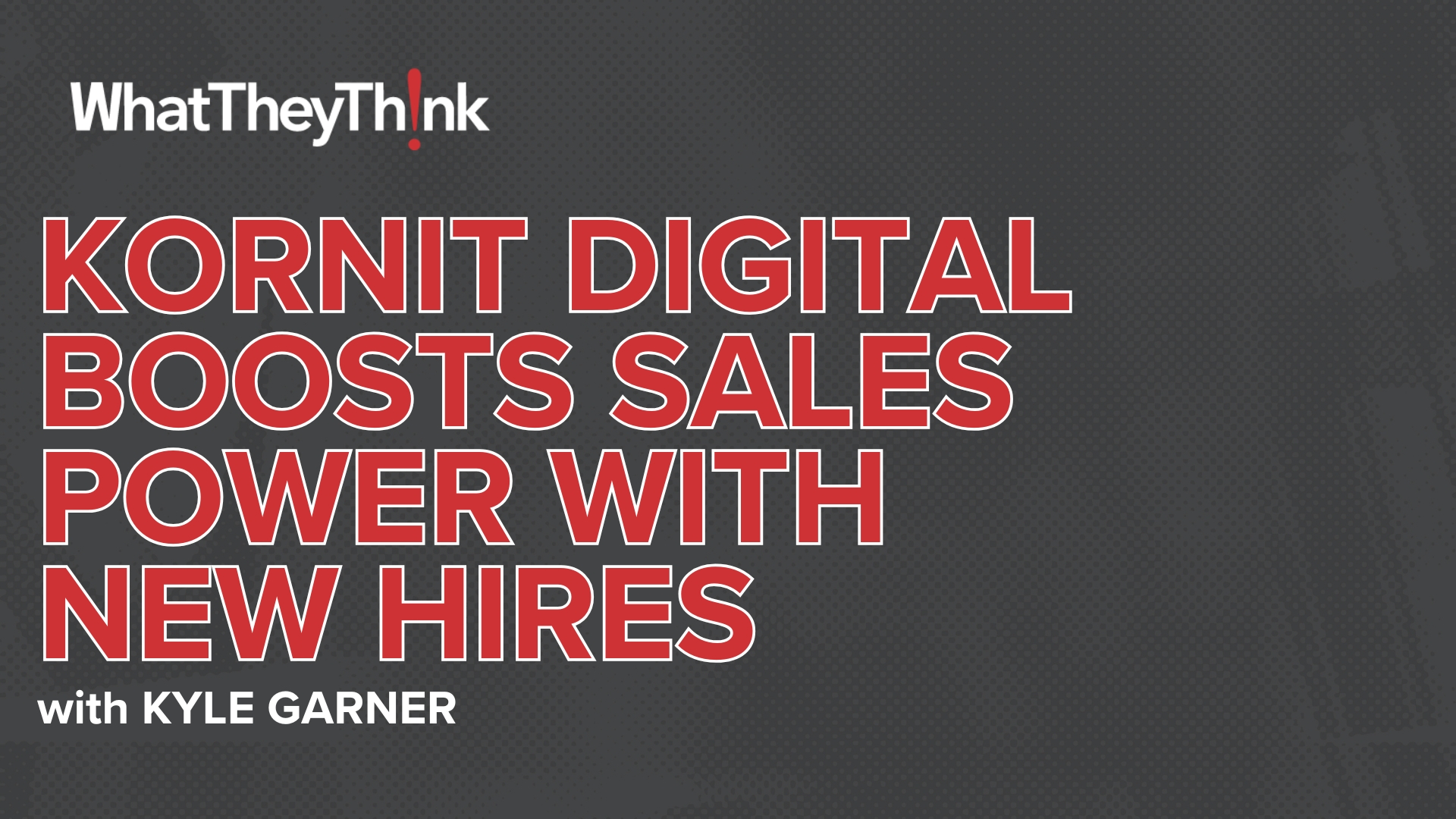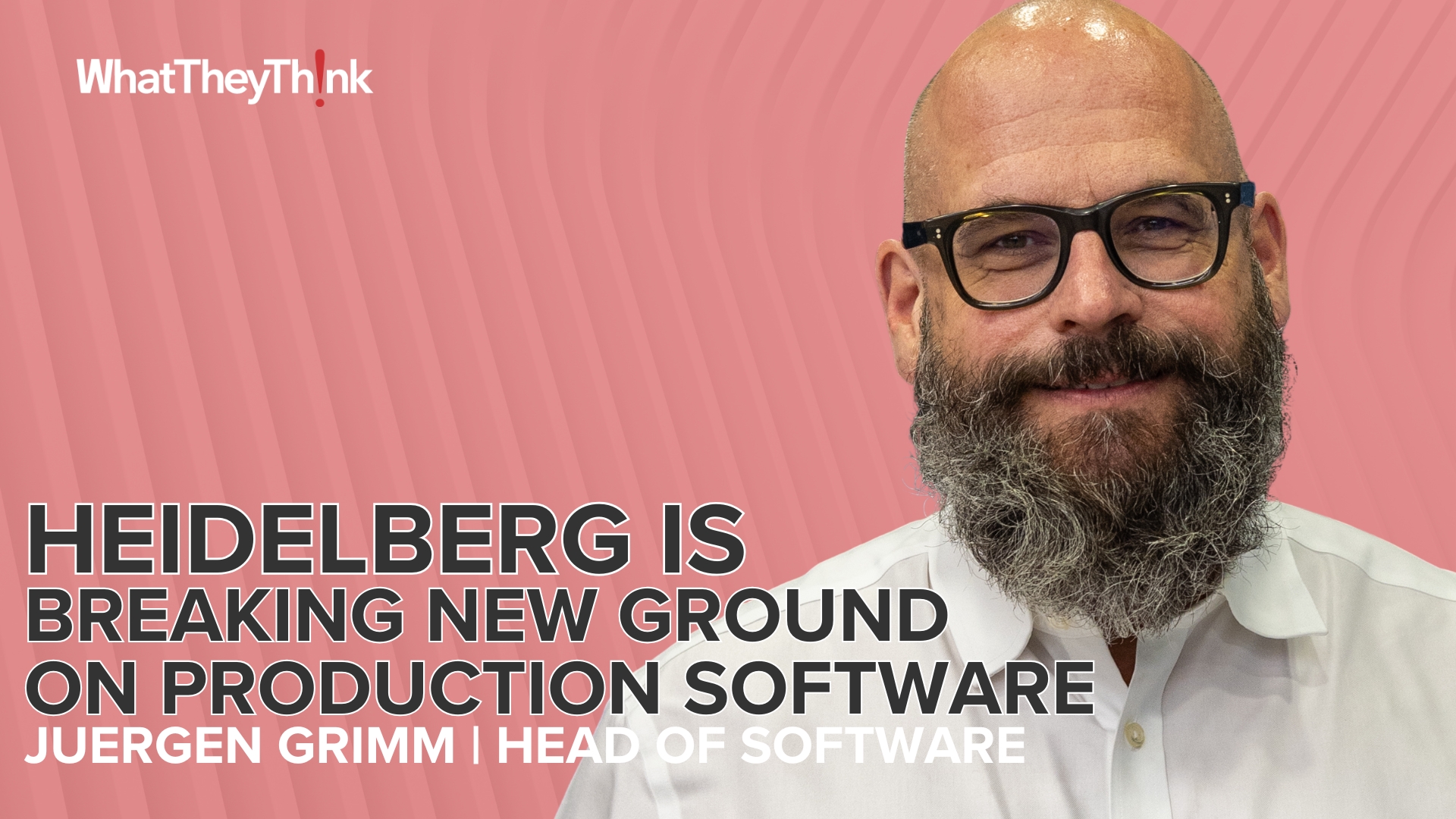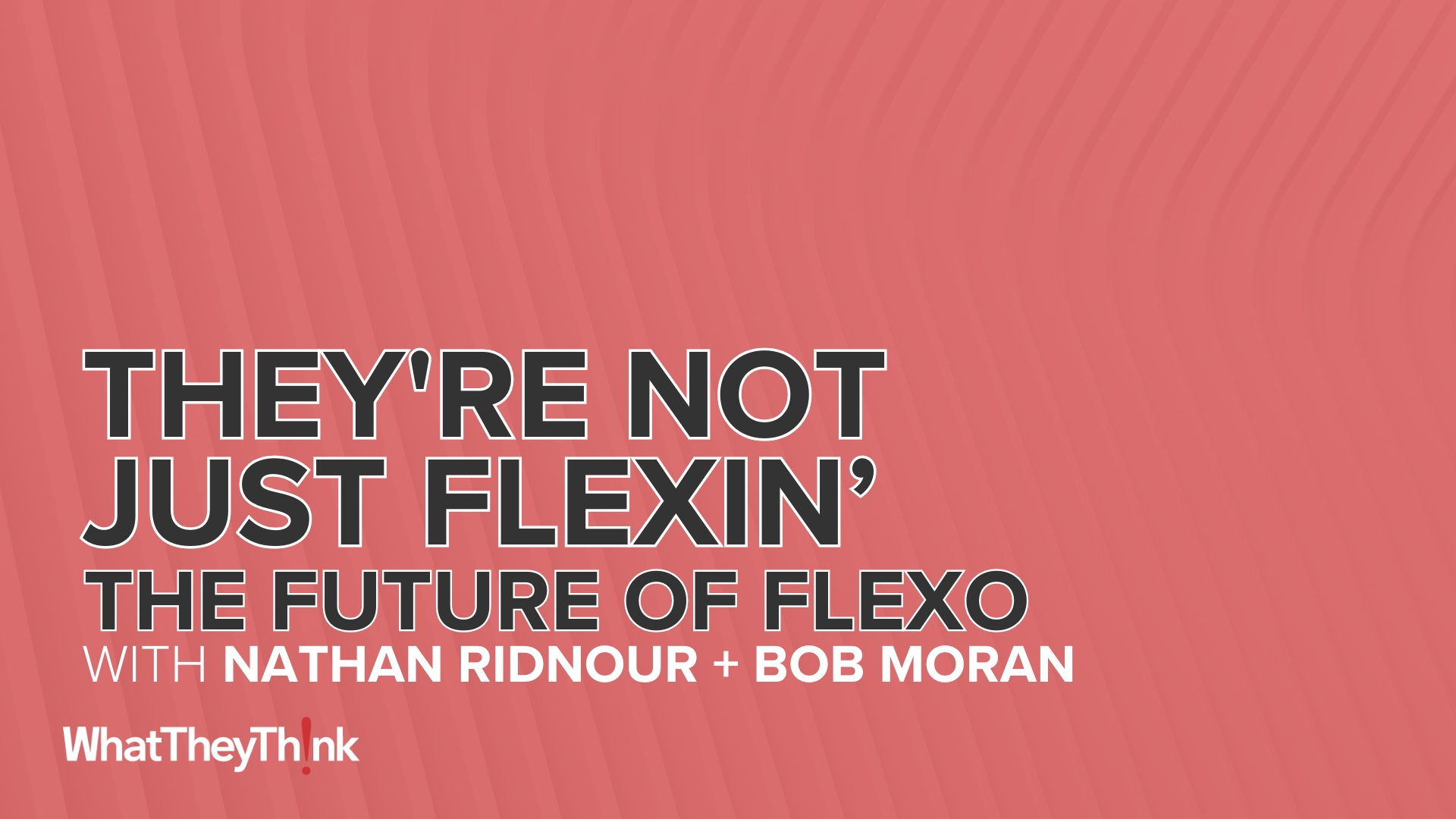Special print effects and press coatings are all the rage these days, as printers are aggressively marketing their abilities in this category, and as marketers have drawn attention to the science behind why humans respond to tangible media.
The good news is, designers are really starting to listen. However, awareness is a double-edged sword. It’s great to see that designers and print buyers are starting to realize the benefits and capabilities of press coatings, and also great that these amazing ink and coating technologies have hit the mainstream—but now printers are charged with meeting the demands of highly creative designs that require multiple press coatings and special effects, while trying to get the jobs through the shop faster, and at the highest level of quality. For many printers who live at the cutting edge, multiple press passes, and off- and near-line coatings are no longer working for their workflows.
A few weeks back, I traveled to two printer-client events scheduled two weeks apart. One was on the east coast, one was on the west coast. Both events were for very successful commercial printers with different clients and different specialties—however, they both had something in common. They both had custom-configured offset presses (different brands) that were designed with special press coatings in mind. In fact, just this week, Japs Olson announced increased productivity with a new, specialized 12-color perfecting press configuration that is driven by the need for high-speed printing and coating on both sides of the sheet in one pass.
Jacki Hudmon, Senior Vice President of new business development at Komori America, confirms the trend, stating, “As our customers continue to strive to offer new and unique products to their print buyers, specialty coating is becoming the proven winner. Komori is definitely seeing an uptick in value-added coating applications from both the packaging and general commercial markets.” Hudmon adds, “Many of the requests we are getting are for direct marketing applications. When a consumer reaches for their mail, a printed piece with a specialty coating will drive the best response rate. This simple fact is creating a greater demand for presses with multiple coaters, new curing methods (HUV, LED) and new coatings.”
A Tale of Two Printers
As I mentioned, my inspiration for this story came from my travels—on the east coast it was Hatteras in New Jersey, and on the west coast, it was Impress Communications in California. After I got home, I circled back around to both companies to get the back story, and to see what was driving the investment.
Hatteras Wows Customers with the Gift of Time
Driven by a deep dive into their offset production data a few years back, the Hatteras team (Tinton Falls, N.J.) determined that 50% of their work involved four-color printing with coating on both sides. At the time, they were really feeling the pressure, as customers were demanding higher quality, lower price, faster turnaround times, with more short-run work in the mix.
A self-professed Heidelberg shop, Hatteras already had two, six-color Heidelberg Speedmaster XL 105s, and a six-color Speedmaster CD 102 in their facility.
They had been closely following Heidelberg’s progress, through trips to six Heidelberg customers in Germany back in 2012, and then Drupa in 2016. They saw the potential in the technology coming to market utilizing perfecting presses and LED curing as opposed to UV curing, which allowed the presses to run faster, using less heat to cure versus UV curing.
They decided to take the leap, and in February of this year, Hatteras announced the installation of a fully customized 12-unit Heidelberg Speedmaster XL-106 Press. It has eight printing units, two coating units, and two drying stations, configured into an LPL arrangement (Print, Coat, Perfect, Print, Coat). Equipped with the most powerful LED drying system available, and with added mercury UV lamps in two stations, the press cures double-sided sheets at a blistering 18,000 sheets per hour. Huge, shiny, and new, this impressive machine has become the focal point of their pressroom, stylishly boasting their brand promise “Print Happens Here” in large block letters on the side.
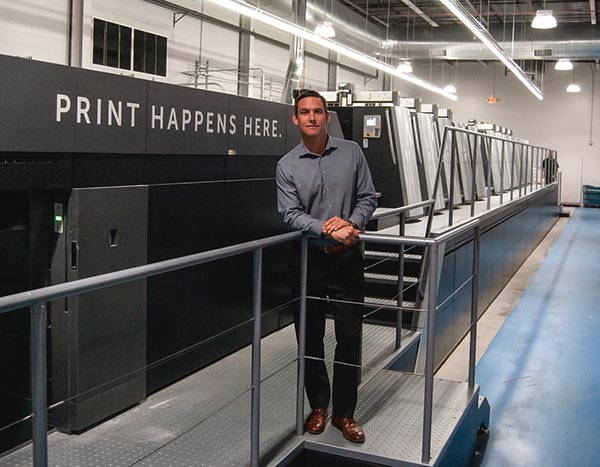
Bill Duerr, President of Hatteras, stands in front of his new Heidelberg Speedmaster XL-106 press with eight printing units, two coating units, and two drying stations in an LPL configuration.
In addition to all of the flexibility gained in the printing and coating/drying units, this press also has “push to stop” technology, which simply means when running the press with similar projects and multiple-form work, the press automatically changes over to the next project without any human intervention whatsoever. Tom Ayala, Vice President of Print Operations at Hatteras adds, “It changes the plates and ejects the previous plate. It washes up both the back cylinders and the blankets. It inks up and then starts up again. We virtually can have a sheet within eight minutes of the last job that was run.”
As expected, the new press is dramatically cutting makeready time, and they’re also seeing huge time savings in long run jobs that would normally occupy a press for days. Tom mentions, “A few weeks ago, we ran a job that was 320,000 sheets, four over four with press coatings. We finished it in 21 hours. That would have taken us over 50 hours on the XL-105 press.”
Although it’s obvious that printing and coating both sides in one pass has led to tremendous time savings on the production side, one of the most valuable benefits has been in the form of customer satisfaction.
Tom tells the story of a retail client who was on-site for a press approval for a project that had three forms (six sides of printing). “Normally, we would have run one side every 1.75 hours on the Heidelberg XL-105, which would have been a 10.5-hour day for the client. Instead, we ran the project on the new XL-106. The client came in at 9:30 a.m., and was out the door by 1:30 p.m., which included time away for a 45-minute lunch break.” Tom shared that the client was thrilled that they had saved him valuable time, and that they’re now seeing this scenario play out over and over again, which they feel is giving them an extra edge over the competition, and building loyalty with their customers.
Bill Duerr, President of Hatteras, couldn’t be happier with his investment. "The combination of technology-driven quality controls, speed, accuracy, and efficiency that Hatteras has gained with the addition of this equipment has exceeded our expectations. It has helped us respond to the needs of our existing customers and opened the door with new customers. We are moving faster and more efficiently than ever!”
Impress Communications Sees Into the Future
Back in 2005, Paul Marino, President of Impress Communications (Chatsworth, Calif.), asked Komori to build him a custom press to his exacting specifications—a press that would dramatically increase efficiencies, and help him stand out among a sea of competitors in the 40” market. Essentially, Paul saw the future in special print effects and press coatings, and Komori was with him every step of the way.
In 2006, they installed a Komori Lithrone S40 eight-color perfector with double aqueous coaters, and six months later, a 6-color Lithrone SX29 with extensive UV capabilities. The presses were ahead of their time when he installed them—his version of the S40 was truly unique, and the SX29 was only the third of its kind (the other two were in Japan). Now, with almost 12 years since the installation, the presses have become even more valuable in the workflow as market demand for coatings have increased, and turnaround times have decreased.
“Today, about 40% of our jobs include UV coating, with the remainder using an aqueous coating,” says Darren Tarlow, Director of Marketing for Impress, “When we are using UV coating, 40% of the time we are using more than one coating on that job. If we’re running a 4/4 job with coating on our four-color press, and comparing that to perfecting on our eight-color press with inline coaters, it is at least 50% faster, and oftentimes more than that. The reduction in make-ready alone creates great time savings.”
The eight-color perfector is definitely the “rock star” of the pressroom, offering speed, automation, and even enhanced sizing options. The press is known as an “option press,” which gives them the ability to handle a smaller minimum size sheet than comparable presses, as well as a slightly larger sheet. “Our standard practice is to say the press handles a 28 x 40-inch sheet,” says Tarlow, “but we can actually go a small margin larger than that. It doesn’t sound like a lot, but we do have some very important jobs we run, where that extra margin makes all the difference and allows the job to run on the eight-color, where we can also do some pretty impressive perfecting tricks.”
Flexibility seems to be the name of the game at Impress. Their six-color SX29 is unique in its own right, with a proprietary, custom-built coating roller that they use when trying to get the most impactful effect out of a particular coating. Tarlow adds, “The six-color also has more flexibility in where we lamp the sheets as they move through the press due to its interdeck configuration, so we can get a bit more specialized in how a job is printed, and how the colors are reproduced by tweaking the lamp positions.”
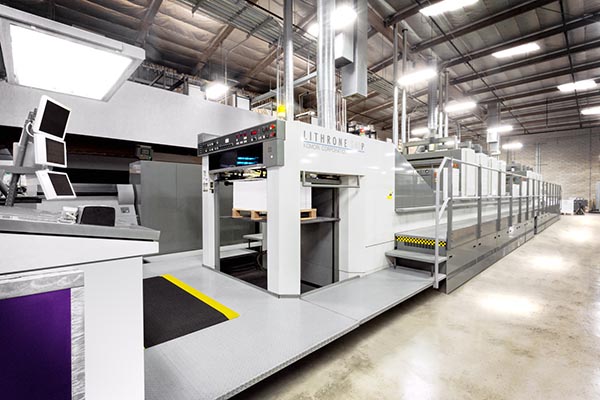
The Komori Lithrone S40 eight-color perfector with double aqueous coaters installed at Impress Communications in Chatsworth, Calif.
Going Green for the Right Reasons
To be honest, I was shocked at first when I found out that their custom presses had been installed almost 12 years prior—I just assumed they were fairly new. So, I asked Darren if the presses were true to the original install, or if there had been any important modifications or updates over the years. As it turns out, the biggest modification has been the addition of HUV ink drying/curing systems, which has been a move that they’ve made on all of their presses. Darren shared that compared to traditional inks, the reduction in VOCs (volatile organic compounds) for HUV is immense, with the inks containing near 0% VOC.
Darren adds, “Where HUV goes even further than standard UV is that it creates an additional 25% reduction in energy usage, on top of the other environmental benefits. These are huge features for many of our clients that have a strong commitment to the environment in their company ethos, which also ties in to Impress’ many eco-friendly certifications and policies.”

